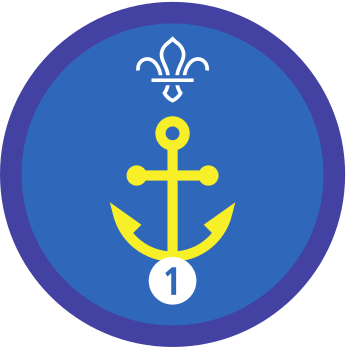
Hoist the colours
You’ll need
- Flagpole
- Boatswain’s whistle
- Sea Scout flag
Before you begin
- Some groups have a specific way that they open their meetings, to give each session structure. Everyone has the chance to come together to say hello and get themselves in the right frame of mind for the activities ahead. This kind of environment is usually helpful to those who’ve recently joined the group, or who’ve come back after time away, to help them feel supported. There’s no right or wrong way to open the meeting, so long as everyone has a moment to come together and reflect.
- Sea Scouts traditionally include a colours ceremony in the openings to their meetings. This is where young people stand in a horseshoe shape around a flagpole, and one of them raises a flag. This opening isn’t for everyone and it may not suit some groups, but we’ve included some instructions for anyone who’d like to try it. See what everyone thinks before starting a meeting in this way, and make sure everyone is confident and happy with the idea. They might have some ideas to personalise their ceremony.
Hoist the colours
- The person leading the ceremony or session should make sure that the flag is attached to the flagpole and ready to be hoisted. If you need to attach your flag, here’s a guide to hoisting a flag.
A red ensign is traditionally used in nautical ceremonies. It’s not broken (unravelled), as a Scouts flag might be. Use whichever flag suits you and your group.
- Everyone should then gather and stand around the flag in a horseshoe pattern, so that everyone can see.
In nautical ceremonies, everyone usually stands in two straight lines, due to the confines of being on the deck of a boat or ship.
- Choose a person to lead the ceremony. In many groups, this is a different person for every meeting. That person should raise the ensign by pulling on the halyard.
Traditionally, the ensign isn’t raised up the main flagpole. It’s raised up a ‘gaff’, which is a shorter section of the main pole angle forwards at 45 degrees. Depending on your meeting space, this arrangement may not be practical to set up.
- Now, someone else should play the Still pipe on a boatswain’s whistle.
- Then, everyone salutes the flag.
Those saluting in naval ceremonies will use the naval salute. Sea Scouts will usually use the traditional Scout salute.
- Finally, your piper should play the Carry on pipe on a boatswain’s whistle. The salute ends and the ceremony is complete.
Reflection
An opening ceremony is a great opportunity to take a quiet moment to remind everyone of where they are and to get into the moment. A ceremony will mean different things to different people, but it’s important to give everyone a personal chance to reflect at the start and end of each meeting, or even just a bit of peace and quiet.
If anyone feels comfortable, they should be encouraged to discuss anything that they might think about or reflect on in an opening or closing ceremony and why it’s important to them.
Safety
All activities must be safely managed. You must complete a thorough risk assessment and take appropriate steps to reduce risk. Use the safety checklist to help you plan and risk assess your activity. Always get approval for the activity, and have suitable supervision and an InTouch process.
If you wish to adapt your ceremony to give it a more nautical flavour, try creating your own flagpole using a range of different nautical knots with the Do moor, be moor activity.
A ceremony is a product of whatever the group wants it to be and can be changed and adapted at will so that it suits everyone. Encourage discussion within the group and come up with different ways to make sure everyone can take part. Creating your own flagpole is a great opportunity to customise it in line with the needs of your group.
All Scout activities should be inclusive and accessible.
You could try out a range of different ceremonies to see which ones the group prefer. Remember that this is supposed to be a quiet moment for everyone to have together, and that most people are likely to be happier in a comfortable position in an open, airy space with few distractions.
This gives the group the chance to shape how their future ceremonies and sessions might begin and end on a regular basis.
